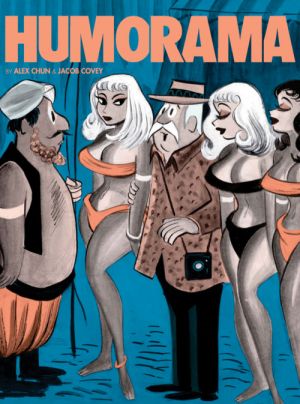- Comics
- Comics Reviews
- Manga
- Comics Reviews
- European Comics
- News
- Comics News
- Press Releases
- Columns
- Spotlight
- Digital Comics
- Webcomics
- Cult Favorite
- Back Issues
- Webcomics
- Movies
- Toys
- Store
- More
- About
By Leroy Douresseaux
September 8, 2011 - 09:59
 |
| The Pin-Up Art of Humorama cover image |
Humorama was a New York City based line of digest-sized magazines mainly remembered for the single panel pin-up and girlie cartoons they contained. Titles such as Breezy, Cartoon Parade, Gaze, Jest, Joker, Romp, and Zip also published black and white photographs of models (Bettie Page, among them) and actresses (such as Tina Louise and Julie Newmar). Humorama magazines also featured jokes of various sorts.
Humorama was a division of the publishing empire of Martin Goodman and was headed by his brother, Abe Goodman. According to journalist and pin-up cartoon connoisseur, Alex Chun, Abe Goodman was the largest buyer of cartoons in the world during the 1950s. Chun has edited several books that focused on cartoonists who plied their trade with Humorama, including The Glamour Girls of Bill Ward, The Classic Pin-Up Art of Jack Cole, and The Pin-Up Art of Dan DeCarlo.
Alex Chun’s latest volume is The Pin-Up Art of Humorama, which is a sort of “best of” collection of the pin-up cartoons found in Humorama’s various magazines. Chun’s frequent collaborator, designer extraordinaire Jacob Covey, essentially re-masters the cartoons in this book and brings them back to life by restoring the accent color (or 2-color) format in which they were originally published. Howard Chaykin (American Flagg!, Black Kiss) provides an introduction to this book that places Humorama and pin-up cartoons in general in a historical context, and he also relates them to his own life.
While it does feature work by the three Humorama cartoonists considered the most accomplished (Cole, DeCarlo, and Ward), The Pin-Up Art of Humorama also offers works by many other notable cartoonists. Readers will find cartoons by Dave Berg of MAD Magazine, illustrator Jefferson Machamer, legendary science fiction and horror cartoonist, Basil Wolverton, and Kurt Schaffenberger, the comic book artist best known for his work on such comic books as Superman’s Girlfriend, Lois Lane during the 1950s and 1960s and Captain Marvel during the Golden and Silver Ages. Humorama also featured the work of three syndicated cartoonists who would go on to have their own newspaper comic strips: George Crenshaw (Belvedere), Bill Hoest (The Lockhorns) and Brad Anderson (Marmaduke).
I am a big admirer of Alex Chun’s efforts at bringing the single panel pin-up art of the 1950s and 60s back into print. I don’t think of his previous publications as archival efforts merely intent on bringing dusty old artifacts out of the basement of magazine publishing history. Many of the visual elements and background details featured in these cartoons have changed since the heyday of the pinup cartoons: cocktail lounges, the architecture, interior design, office furniture, clothing (men wearing suits even in casual situations), and gender roles. However, the two most important things about them have not fallen out of favor – sex and humor.
Chun and the exceptionally talented graphic designer, Jacob Covey (who has designed several of Chun’s books), get the heart of why many of these cartoons are still bawdy, funny, sexy, and even relevant when it comes to relationships between men and women – 50 to 60 years after they were first published. The pay-to-play, the gold-digging, the lust, the office politics, the spouse who is cheating or has a wandering eye are all familiar to practically any adult reader. Even those who are not fans of comics can look through this book and recognize the humor, idea, and story (of a sort). The subject matter is timeless, and in the context of American culture, perhaps universal.
This is not a fine art book. Besides, there are works of art and artists that are no longer relevant and have been reduced to being important in the history of art. The single panel pin-up cartoons in Humorama publications were not meant to be fine art, but rather to be entertainment. Yet these cartoons did not entertain by simply appealing to the prurient interests to the buyers of such publications. Readers recognized such visual cues as scantily clad women and also the men whose hearts and libidos they sent racing. The readers got the joke about the machinations of scheming female characters and knew how the minds of the male characters worked.
We still get that, and so do Alex Chun and Jacob Covey. Chun fills his collections with the best cartoons – the ones that can still delight readers, and Covey uses his lively and inventive design sense to make these old cartoons fresh and vital. With The Pin-Up Art of Humorama, Chun and Covey will once again make you believe that the art of Humorama is still alive and kicking – although the line ceased to exist decades ago.
A